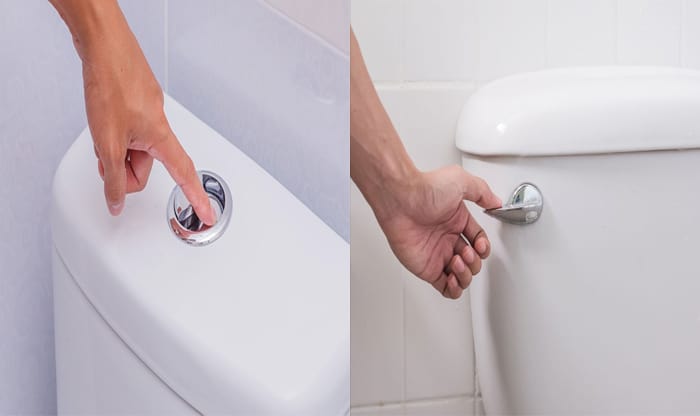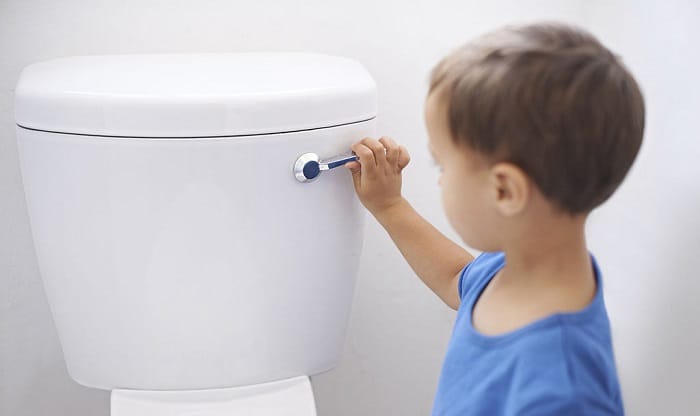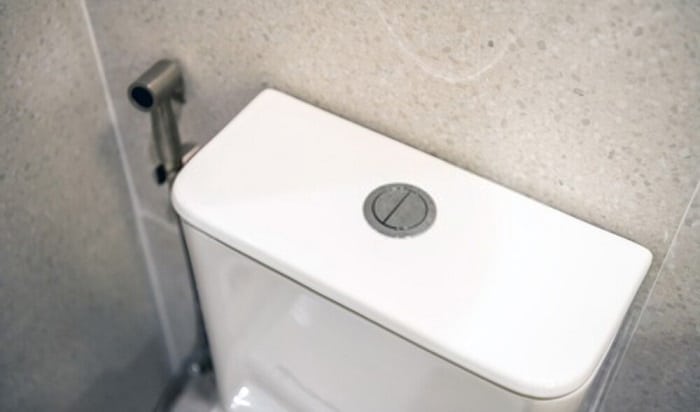Whether you’re renovating your toilet, getting a new toilet or something better, it’s worth spending time going over dual flush vs single flush toilets. Typically, single flush toilets are found in older houses and most buildings. There’s the same amount of water per flush regardless of the type of waste being disposed of.
On the other hand, a dual flush toilet offers two dual flush options. The full flush is for solid waste and the half flush is for liquid waste. This is referred to as an interactive design for saving water.
This article will show you the difference between single and dual flush toilets. You should understand the key features to be wise in making a purchasing decision.
Table of Contents
Features of Dual and Single Flush Toilets
Dual Flush Toilet
There are two flush cistern converters in a dual flush toilet. As mentioned, the full flush is intended for solid waste and the half flush is for flushing liquid waste because it’s not bulky. You should know that there’s a split in the water consumption ratio used on dual flush. It should start with 6/4 and be changed to 5/3 or 4/2.6 to save more water.
It’s possible to convert an old toilet with a single flush into a dual flush system. Some modifications can be done by adding a dual flush valve inside the cistern. Updating the toilet’s lever or button is also essential to complete the upgrade.
To make upgrades effortless and uncomplicated you can find a button on some dual flush toilets. An example of this is the Macdee Kayla Cable. It’s designed for DIY and without the need to call the plumber.
PROS
- Eco-friendly and water-saving option
- Can allocate the proper amount of water due to its dual flush options
- Best for residential use
- Has awesome aesthetic appeal
CONS
- Some replacement parts for repairs may be hard to find
- Harder to operate; Elderly persons, handicapped, and young users may struggle in pushing it
Single Flush Toilet
The description of this toilet is simple as it’s a cistern flushing instrument with one, full flush. Generally, a standard toilet uses 1.6 gallons of water per flush. By pressing the button or pulling a lever, around 6 liters of water can be utilized daily for one person.
The majority of older toilets are with a single flush system which was common in the past. As there’s progress on cistern innovation and toilet design, the environmentally friendly, dual flush system came into existence.
Even so, some still utilize the single flush toilets that function with 1.6 gallons per flush. The stocks don’t run out in the market and you can buy them any time you want. The leading ones are KOHLER 3811-96 and TOTO Drake CST776CSFG.
Single Flush Vs Dual Flush Toilets: Key Features to Look at for Comparison
Flushing Systems
A dual flush toilet is assembled for saving water but some users reported experiencing difficulty as they need more force when pressing the flush button. Elderly and handicapped people specifically with wrist and hand arthritis would find it inconvenient.
However, you may also have the chrome trip lever which is less challenging. Still, it can’t be overlooked that single flush toilets are the ideal option when an easy flushing system is what you need.
Water Usage
Single flush or the so-called ‘gravity toilet’ is commonly seen in the market. When they were first introduced in the market, a lot of water was needed to push down waste. Due to advancement, single flush toilets in America only need 1.6 gallons or less for every flush.
With improvements, the country implemented the use of 1.6 GPF or less. Back then, five gallons of water was utilized in a single flush. But there are high-efficiency toilets that only need less than 1.28 GPF of a single flush like the American Standard 2988101.020.
Double flush toilets need 1.6 gallons for full flash and only 0.8 gallon for a half flush. The full flash is dedicated to flushing down solid waste while the half flush is for clearing liquid waste or urine.
That’s why there are two buttons on dual flush toilets for the two flush options. When there are only a few users, it works the best. This setup will let you save water and lower your water bill. A single flush is suitable in high-traffic areas like busy public restrooms that have multiple users.
When it comes to water efficiency and conservation, the dual flush toilet is the winner due to its dual flush option.
Read more: 1.28 vs 1.6 gpf toilets: what is the difference?
Aesthetics
You have to look at more than just one and two-piece toilets when looking at the toilet’s appearance. The strength of a single flush is contained in its aesthetic appeal. Your toilet’s ambiance depends on your taste but its ability in blending with the environment is beneficial to interior design.
Hence, you can turn it into a bathroom décor. Additionally, it has a flush valve that is open for modifications so you can match the toilet with your chosen motif. It won’t be possible with dual flush toilets because of the challenge it poses with pressing the buttons on the tank.
Eco-friendly
If you care too much for the environment, opt for dual flush toilets because less water is needed in every flush. They can wash down waste without wasting water. Use them and you can save money.
You may also get rebates when purchasing a high-efficiency toilet. Some do it when replacing an older one for a new home.
Cleaning and Maintenance
When it comes to cleaning, both are not easy. The demand will depend on the design of the toilet tank, tank lid or rim, and bowl. You should also take the toilet’s material and flushing power into consideration.
But know that dual flush toilets are costlier and more challenging to maintain. It’s because their necessary spare parts are hard to find. Due to the popularity of the single flush toilet, their components are sold everywhere.
When you need a lever or flush valve and other replacement parts, you can find them in the local stores. You better look online for the ones that suit a double flush toilet.
Maintenance Costs
Lastly, you have to be aware of the maintenance cost of each toilet, which will involve replacement costs. Dual flush toilets are costlier than the ones with single flush as mentioned earlier.
You can’t avoid spending money after installing a toilet in a new house as it’s essential for good working conditions. Although you’ll spend more on maintaining a dual flush toilet, it will appear to be more economical in the long run. It’s based on the lower water consumption that you can save money.
Be smart enough to choose a quality toilet like WOODBRIDGE T-0019, Kohler K-3999-0, Swiss Madison SM-1T254, and DeerValley DV-1F026 so it can serve you for a long time.
Tips on Saving Money on Water Bills
Although water consumption and cost are also weighed on single vs dual flush toilets, here are some tips to boost the water efficiency of any toilet that you choose.
- Add something like a PVC bag or plastic bag with the toilet cistern. By doing so, the toilet will use less water when flushing.
- Having a cistern converter in your bathroom is a way of lowering your water consumption. You can get a flapper valve and water-saving fill valve from conversion kits sold in the market.
Summing Up
Although there are differences between dual flush vs single flush toilet, each feature is made to serve a specific purpose. Every need and demand of users are met in this way. Since the article showed you those things, it will be easy for you to decide which one will work for you.

I’m Paulk Webb, and I work as a writer for Saveourwaterrebates. I’m happy to put in the time and effort to conduct market research to identify the most pressing issues faced by households concerning their plumbing. Feel free to check out our guides to get the most informed recommendations for how to solve your problems.




